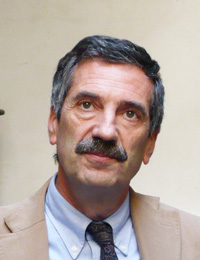INFN IN EUROPE
Interview with Fernando Ferroni, President of the Italian National Institute for Nuclear Physics.
 Let's start from the future: what is INFN’s part in ESFRI, the European Strategy Forum on Research Infrastructures?
Let's start from the future: what is INFN’s part in ESFRI, the European Strategy Forum on Research Infrastructures?
The first major project in which INFN is a leading player in ESFRI is certainly Km3Net, the underwater observatory for neutrinos off the coast of southern Sicily: besides being hosted in Italy, numerous INFN researchers are among its project leaders. In addition, INFN, along with CNR and Electra, for Italy, were recently given the go-ahead to join the European Spallation Source (ESS) project to build the world’s largest neutron source, in Sweden. This infrastructure offers high potential for basic research and has important multidisciplinary implications. INFN has already started to provide part of the contribution in kind provided for in the participation agreement. In the context of the Extreme Light Infrastructure (ELI) project, INFN is leader of the group responsible for the construction, in Romania, of ELI- NP for nuclear physics applications, and is actively involved in the ELI MED project, dedicated to ELI medical applications. INFN’s formal participation in the X-ray free electron laser (XFEL) project and Facility for Antiproton and Ion Research (FAIR) project in Germany is also under discussion.
In addition to the projects under development, what actions is INFN taking towards Europe?
As in the ESFRI context, the idea of setting up a European Research Infrastructure Consortium (ERIC) for major research infrastructures - including for example Km3net and ESS - is becoming increasingly popular. We are currently discussing with other EU countries the possibility of establishing this type of legal framework for INFN’s infrastructures with a strong European impact, in which EU countries are directly involved. Among these there are certainly the Gran Sasso Laboratory, which for many years has been hosting researchers and experiments from around the world, and the EGO French-Italian Consortium for measuring gravitational waves, near Pisa. We also plan to use our existing collaborative networks to create an ERIC for Cultural Heritage. Whether the infrastructures are dedicated to basic research or technological applications, the ERIC legal framework would ensure more agile and intense collaboration between the countries involved and strengthen the development of research and technology transfer.
What are the main points of contact with the Horizon 2020 programme?
INFN has been taking part for many years, very often as leader, in many thematic calls on a wide spectrum of areas. INFN has undertaken strategic commitments regarding technologies applied to the field of cultural heritage and the development of new accelerator technologies, in particular in the field of plasma-wave acceleration. Over the last decade significant investment has been made in computing, particularly in High Performance Computing projects, in collaboration with national and worldwide computer centres and leading industries, such as Cineca and Eurotech. In computing services, INFN's activity is particularly aimed at the expansion of Grid services, originated from several successful INFN projects in FP7, on Cloud platforms, in conjunction with other partners interested in their application to other areas of the expertise acquired by INFN in the management of LHC computing at CERN. INFN has also acquired considerable experience in the design of Digital Agenda services, such as Marche Cloud OCP (Open City Platform), a public service prototype for access to medical records which, supported by Marche Region, can be easily extended to other regions of Italy and to other application fields. Using structural funds, there will also be the new phase of the Km3Net project for the construction of a scientific observatory able to integrate research on neutrinos, sea sciences and geo-volcanology, in connection with the Etna monitoring activity developed by INGV. On the training front, INFN is involved - among others - in the higher education pilot programme using the structural funds of Abruzzo Region, with a centre at the Gran Sasso National Laboratory.
Given the number of Italian researchers involved and the level of roles covered, CERN absorbs a considerable part of INFN's commitment at the European level.
CERN is our reference for accelerator research at the European and global level and will continue to be so for some time to come. LHC is currently in an upgrade phase and will start up again in the first half of 2015 with the opening of the new phase, in which we will be involved for the next 15 years or so. The recently approved LHC High Luminosity project will begin in 2018 and will accompany CERN to the end of the next decade. Immediately after that we will need to establish a new direction, also as a result of the new physics that LHC will allow us to investigate starting from next spring. The strategy must be determined at a global level and, while American researchers continue to increasingly focus their efforts on the study of neutrinos, CERN will continue to have the task of building accelerator machines at the energy frontier. There are plans to double the energy for which the LHC was designed, following the development of new superconducting magnets, which also exploit the extremely advanced know-how of Italy and INFN in this field. An alternative hypothesis regards the construction of new colliders larger than the LHC, but we will not know the advisability of this choice for some years.
JULY 2014



